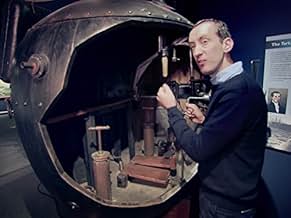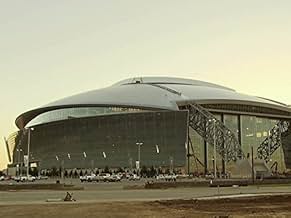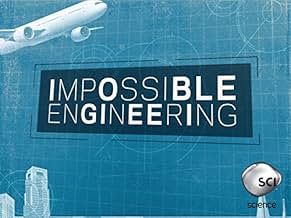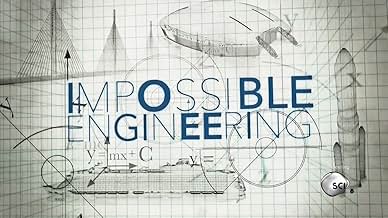IMDb-BEWERTUNG
7,1/10
305
IHRE BEWERTUNG
Eine Reihe, die sich mit technischen Megaprojekten auf der ganzen Welt befasst und sie mit den ursprünglichen wissenschaftlichen Entdeckungen in Verbindung bringt, die diese modernen Projekt... Alles lesenEine Reihe, die sich mit technischen Megaprojekten auf der ganzen Welt befasst und sie mit den ursprünglichen wissenschaftlichen Entdeckungen in Verbindung bringt, die diese modernen Projekte möglich gemacht haben.Eine Reihe, die sich mit technischen Megaprojekten auf der ganzen Welt befasst und sie mit den ursprünglichen wissenschaftlichen Entdeckungen in Verbindung bringt, die diese modernen Projekte möglich gemacht haben.
Folgen durchsuchen
Empfohlene Bewertungen
The concept is great. Explain how engineers have created modern marvels, drawing upon past experiments by their predecessors. However, the actual show is unbearably drawn out. I only watched one episode; about the Shanghai Maglev Train. Fascinating subject but it was a half hour documentary padded out to last twice that long. I lost count of the number of times the same shots were re-used; the music was intrusive; the repetitive commentary was aimed at an immature audience and what exactly was the presenter in Shanghai doing? If she was presenting the show then she should have been doing it to camera; if she was an interviewee then she should have been directed to keep her eye line closer to the camera, not be staring into the middle distance. Viewers have to sit through a whole hour of this stuff, just to enjoy a handful of three minute bursts of interesting information separated by plenty of padding. The only reason I give it 4/10 is for a few engaging sequences of archive material and modern experiments, with appropriate homages to the engineering pioneers. Oh and by the way, Nigel Gresley's streamlined locomotive is usually called "Mallard" and not "The Mallard" but it's a moot point so no marks lost there.
Although this show does lack in the animation and graphical effects it is very good at the history of the engineering topic. The show highlights a project and then goes back in history and explains how the technology was developed. The show highlights several different specific engineering challenges relevant to the project and then tells the history behind each challenge. The show really dives into the historical significance of engineering ingenuity and how it impacts the project. They cover old technology and why it didn't work and what replaced it and why it's better. I find this show to be very interesting and well done from an Engineers standpoint. The show really encapsulates the saying "Standing on the shoulders of giants" from Issac Newton stating that his discoveries were dependent on other peoples past discoveries.
Season 2, Episode 1. "Scientists believed, because there's no air in space there would be nothing for the rocket to push against so it wouldn't be able to fly... but Goddard had other ideas"... This coming out of the mouth of a real scientist... NOBODY who studied physics since Newton believed that!!, especially scientists!!! Maybe an infamous newspaper editor put his foot in his mouth claiming so but he was quickly put in his place by thinking people. Goddard, of course a genius, didn't go against known science and believed that in space his rocket would work, he KNEW it would work, Just like Columbus didn't go against general knowledge and bet that the world was round, he knew it was round... Sometimes I wish they would sell us straight science and not some trumped up dramatic crap... we deserve better and maybe one day the producers of these shows will treat us with respect. Very sad.
Great intent. They constantly repeat and repeat and repeat to make the show longer. Just tell the story.
I watched recent episode of Impossible Engineering about a North Sea wind farm described as the London Array.
In the story they described a groundbreaking windmill which pioneered many great innovations. This turbine supposedly produces 2MW and has over its lifetime produced 21 million KWH of electricity. This would then be 21 x 10^9 WH. The statement they made that I disagree with is they said over its life it produced enough energy to power New York City for THREE YEARS! This did not seem right to me. According to Google search, NYC consumes 11,000MWH per DAY; bringing back to the above common terms, that would be 11 x 10^9 WH. So you can see from this that the output of that turbine over 40 years would have only supplied NYC's needs, using round numbers, for only TWO DAYS, not 3 years! To put it another way, IF That turbine does in fact put out 2 GW (and it probably doesn't considering the wind does not blow all the time), then it would require (11 x 10^9)/(2 x 10^6) = about 5000 such turbines working at full capacity to meet the needs of that mighty city. There is a lot of talk about misinformation these days. If the misinformation comes from a conservative it seems to get branded as "Fascist" or other bad words. But in a case such as this, the creators would probably respond with a shoulder shrug and mumble something about a typo or honest mistake, because, after all, it was in support of the GREEN agenda.
Don't misunderstand, I am in favor of wind and solar power when placed in optimum locations and when it makes economic sense, but misleading people with a false fact such as described above is detrimental to the discussion. I DO enjoy watching the show, and I think it is great to inspire (especially) young people to do great things; this particular piece just stuck in my craw.
In the story they described a groundbreaking windmill which pioneered many great innovations. This turbine supposedly produces 2MW and has over its lifetime produced 21 million KWH of electricity. This would then be 21 x 10^9 WH. The statement they made that I disagree with is they said over its life it produced enough energy to power New York City for THREE YEARS! This did not seem right to me. According to Google search, NYC consumes 11,000MWH per DAY; bringing back to the above common terms, that would be 11 x 10^9 WH. So you can see from this that the output of that turbine over 40 years would have only supplied NYC's needs, using round numbers, for only TWO DAYS, not 3 years! To put it another way, IF That turbine does in fact put out 2 GW (and it probably doesn't considering the wind does not blow all the time), then it would require (11 x 10^9)/(2 x 10^6) = about 5000 such turbines working at full capacity to meet the needs of that mighty city. There is a lot of talk about misinformation these days. If the misinformation comes from a conservative it seems to get branded as "Fascist" or other bad words. But in a case such as this, the creators would probably respond with a shoulder shrug and mumble something about a typo or honest mistake, because, after all, it was in support of the GREEN agenda.
Don't misunderstand, I am in favor of wind and solar power when placed in optimum locations and when it makes economic sense, but misleading people with a false fact such as described above is detrimental to the discussion. I DO enjoy watching the show, and I think it is great to inspire (especially) young people to do great things; this particular piece just stuck in my craw.
Top-Auswahl
Melde dich zum Bewerten an und greife auf die Watchlist für personalisierte Empfehlungen zu.
- How many seasons does Impossible Engineering have?Powered by Alexa
Details
- Erscheinungsdatum
- Herkunftsland
- Sprache
- Auch bekannt als
- Impossible Engineering: Extreme Railroads
- Produktionsfirmen
- Weitere beteiligte Unternehmen bei IMDbPro anzeigen
- Laufzeit
- 1 Std.(60 min)
- Farbe
Zu dieser Seite beitragen
Bearbeitung vorschlagen oder fehlenden Inhalt hinzufügen





















